#3d floor plan maker
Explore tagged Tumblr posts
Text
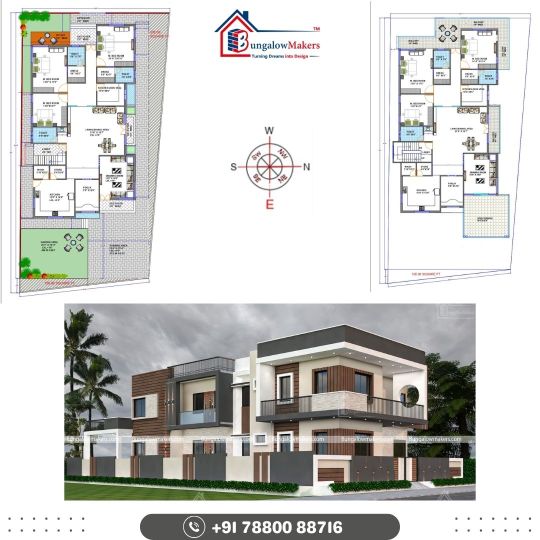
Floor Plan Design
Bungalow Makers is the top floor plan design company in Indore offering services all over India. We offer Floor plans for houses, apartments, offices, vintage, bungalows, or any other commercial places. Our Floor Design plan services are affordable in cost.
Other Complete House Plan Services We Offer:
Interior Designs
Interior and Exterior Elevation Designs
2D and 3D Elevation Designs
Site Visits
Complete Structural Drawings
#Best architect agency in India#House design Package#Residential Apartment Designs#Best House Designers#Best Online Architect Services#architects & interior designers in India#Bungalow Makers#Ultra Modern House Design#Floor Plan design#Interior Design Company#architectural and interior Design#architecture engineer#duplex house plans#30x50 house plans#3d elevation design#house 3d elevation#Traditional House Design#House Plan#House Design Plans#home interior design#house plan design#duplex house design#house elevation design#house plans#1200 sq ft house plans#home interior designs#kitchen interior designs#bedroom interior designs#Kerala House Designs#elevation design
5 notes
·
View notes
Text
Transform Ideas into Reality with Professional 3D Walkthroughs
Imagine presenting your architectural designs in a way that allows clients to walk through them before they’re built. With 3D Rendering Pro, you can! Our 3D Walkthrough Animation Services deliver highly realistic, immersive experiences that bring every project to life. Whether it's a high-end real estate property, an office complex, or an interior design concept, our detailed animations showcase every aspect with clarity and precision. Our team of skilled 3D artists ensures perfect textures, lighting, and movement, creating a virtual tour that feels real. Ideal for architects, real estate developers, and designers, our walkthroughs help communicate ideas effectively and impress potential investors and buyers. Enhance your presentations with stunning 3D visuals that set your project apart. Contact us today and let us turn your vision into a breathtaking digital experience!

#3d animation services#3d animator#3d model#3d movies#3d animation company#3d render#3d modeling#3d animated film#3d animation#3d rendering services#3d reality#3d animated story 2025#3d art#3d artwork#3d rendering#3d movie maker#2d animator#2d animated film#2d animated video#2d animation#2d art#2d floor plans#3d walkthrough#animation#animation services#visualization#visualization techniques#movie making#rendering services#3d rendering company
0 notes
Text
Twisted Wonderland Fes 2023 Notes
(this is very stream of consciousness, based on notes taken during the event)
・After the livestream cut out there was a virtual concert: 3D animations of the characters performed Absolutely Beautiful and the Glorious Masquerade song
・Jamil and Kalim’s VAs held hands at the closing of the curtain so cute
・Before the livestream was an amazing, long-form version of Piece of My World. Longest version I have ever heard--it lasted throughout the entire time the VAs were appearing on stage and might have been specially composed for the event.
・The first part, pre-livestream, was a live script reading by all cast, split into two halves: the VAs for Riddle, Cater, Jack, Azul, Floyd, Kalim, Epel, Vil, Silver, Lilia performed a scene of making summer break plans to got to a beach together. The VAs for Ace, Trey, Deuce, Ruggie, Leona, Jade, Jamil, Rook, Ortho, Malleus, Sebek performed a scene of participating in a menu creation contest for the school cafeteria. Basically voiced vignettes, but instead of the characters, it was the VAs themselves, reading live in front of the audience. Really amazing.
・Then the livestream began, including a lot of Book 7 and Stitch event talk. Jamil’s VA Futaba insisted that Jamil has the coolest unique magic and so they held a vote, it was hilarious. They all have great chemistry and seemed to really enjoy it. The “what unique magic is coolest, snake whisper vs unleash beast vs Shock the heart vs silver’s unique magic” argument was hilarious. No one voted for Oasis Maker, Sebek’s VA voted for Silver’s, Jade's voted for Azul's.
・When idia’s VA have his video message all the VAs watched via little monitors on the end of the stage, but Ortho’s Aoi turned around in his chair to watch the big screen.
・When Jack did the in-game exam battle all the VAs got out of their chairs to turn around and sit on the floor to watch, but Ortho’s Aoi stood and did Ortho’s attack gestures along with the battle, it was adorable. Aoi had some great comments on Book 7, too. Lilia’s VA is very good at the battles and instructed Jack’s VA on how to get a good exams score.
・And the new info was all shared via livestream! The new birthday series will be redrawings of all the characters from the platinum suit series (same poses and everything, pre-groovy), new Halloween event is Pinocchio, an SSR platinum suit Grim is coming!
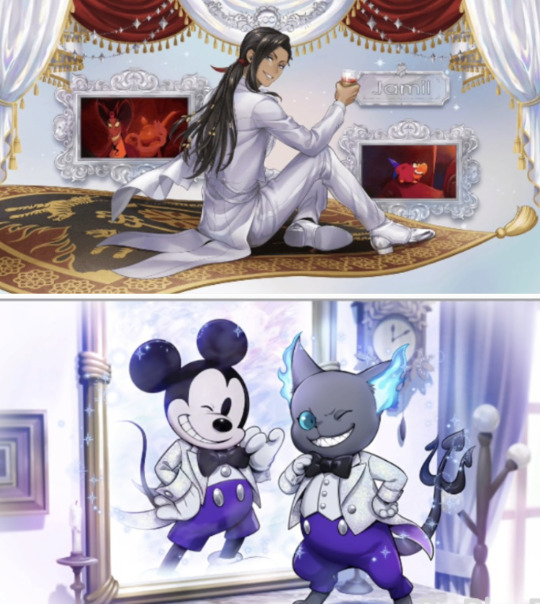
・They had Leona’s VA play the hydra game from Book 6.
・Malleus’ VA talked about Book 7 and how he feels bad for Malleus.
・Ortho’s Aoi had idia’s light ring and said “I brought my brother” when he did his introduction at the beginning. Most (if not all) of the VAs wore light rings for their character, and were dressed in colors reminiscent of their dorm.
・Kalim’s kept showing off his muscles and Jade’s VA thought he was hilarious. At least twice, Jade’s VA was doubled over laughing at whatever it was Kalim’s VA was doing, it was so funny, he could not keep it together.
・Vil’s VA said that there’s a grandma version of the grandpa recording that he made for book 6 and he didn’t know which one the director was going to go with until the game came out.
・Ortho’s VA shared ideas for gear for Ortho, such animals like a fox. And also shortcake gear that smells like cake.
516 notes
·
View notes
Text
Walking Through Dreams: How 3D Tours are Changing the Way We Build in India

Have you ever tried explaining what's in your head to someone else? Not just any thought—but the exact layout of your dream home with all its perfect details? It's like trying to describe the taste of your grandmother's special chai to someone who's never had it.
For decades, this has been the struggle of every architect and builder in India. We draw lines on paper and ask clients to imagine their future. And they nod politely while thinking, "I have no idea what I'm looking at."
I'll never forget when Mr. Sharma brought his wife to review blueprints for their new flat in Pune. He had studied them carefully, but when Mrs. Sharma asked, "Where exactly will I see the sunrise while having my morning tea?"—the limitations of 2D plans became painfully obvious.
From Paper Dreams to Virtual Reality
Today, those blue papers are being replaced by something revolutionary: 3D walkthrough animations that let clients actually experience their homes before a single brick is laid.
When the Joshi family came to us for their three-bedroom in Bangalore, we didn't just show them floor plans. Instead, we invited them to put on VR headsets and "walk" through their future home. Ten minutes later, Mrs. Joshi was rearranging virtual furniture in her living room while her husband was checking how the evening light would fall on his reading chair.
"This isn't just a house tour," Mr. Joshi said afterward. "This is us living there already."
The Mistakes We Never Made
The real magic of 3D walkthroughs isn't just in the pretty visuals—it's in the problems they prevent.
Take the Malhotra project in Delhi. Everything looked perfect on paper for their luxury townhouse. But during the virtual walkthrough, their teenage daughter Priya immediately noticed something none of us had caught.
"Wait," she said, stopping in the hallway. "If the bathroom door opens this way, you can see straight into it from the living room when guests are over."
One small observation. One simple door swing adjustment. Zero rupees spent on fixing an embarrassing mistake during construction.
The Confidence Factor
What surprises me most after introducing 3D walkthroughs to our process isn't the technical benefits—it's how they transform the client's emotions.
I remember Rajiv and Anita Patel, a young couple buying their first home in Mumbai. They came to every meeting anxious, second-guessing every decision. But after experiencing their future home virtually, something changed. The questions shifted from worried "what-ifs" to excited planning.
"We can actually see ourselves living here," Anita said, her voice steady with newfound confidence. "I know exactly where my mother will sit when she visits. I can see how the kids will play in that corner."
With tools like V-estate, our clients aren't just spectators—they're directors. They can change wall colors with a click, try different furniture layouts, or check the view from their balcony during different seasons. This control transforms even the most anxious buyers into confident decision-makers.
The Business Side of the Story
Yes, creating detailed 3D walkthroughs requires investment. But the returns speak for themselves.
For a housing development in Hyderabad, we tracked the difference between units marketed with traditional methods versus 3D experiences. The results? Properties with immersive walkthroughs sold 35% faster, and—here's the real magic—had nearly 40% fewer change requests during construction.
When Mr. Agarwal, one of our developers, saw these numbers, he said it best: "We're not spending money on fancy visuals. We're investing in clarity. And clarity pays dividends."
From Luxury to Necessity
Not long ago, 3D visualizations were something only luxury developers in Gurgaon or South Mumbai could afford. Today, we're implementing them for projects from affordable housing in Tier 2 cities to weekend homes in the hills.
Why? Because at its core, this technology solves a deeply human problem: the need to understand and connect with the spaces where we'll build our lives.
When Divya and Arjun Mehta were planning their retirement home in Coimbatore after 30 years of living abroad, they were understandably anxious about building something sight unseen. But after experiencing their future home through a detailed 3D walkthrough—seeing exactly how the morning sun would fill their yoga room, how their grandchildren would play in the garden they had imagined—their anxiety transformed into excitement.
"It's not just a house anymore," Divya told me, eyes shining. "We can already feel it becoming our home."
And that feeling—that emotional connection to spaces that don't yet exist—that's not just good technology. That's good building. That's good living. And in an industry built on turning dreams into reality, that's everything.
0 notes
Text
3D Graphic Walkthrough Video Makers in Hyderabad
3D Graphic Walkthrough Video Makers – Transforming the Future of Visualization
Introduction:
In the realm of design, architecture, and real estate, visual storytelling has become a critical tool for conveying complex ideas. One of the most innovative and impactful methods for doing so is through 3D graphic walkthrough videos. These videos provide an immersive and interactive experience, allowing clients to virtually navigate through spaces before construction begins. Whether you're an architect, a real estate developer, or a design professional, a 3D walkthrough video can elevate your project and impress your audience.
What is a 3D Graphic Walkthrough Video?
A 3D graphic walkthrough video is a computer-generated simulation of a space or environment, where viewers can explore a 3D model of the interior or exterior. These videos are designed to offer a realistic representation of how a space will look, feel, and function, even before the actual construction begins.
From a dynamic viewpoint, viewers can "walk" through a building, appreciating its design, layout, and intricate details. These videos are not only visually engaging but also provide a strong sense of spatial awareness, which traditional 2D images or blueprints cannot convey.
Why Choose 3D Graphic Walkthrough Videos?
1. Enhanced Visualization
One of the biggest challenges in presenting architectural designs is conveying the full experience of a space. 3D walkthrough videos enable a realistic, detailed, and interactive visual representation, helping stakeholders understand every angle, material choice, and architectural element.
2. Better Client Engagement
When it comes to selling or presenting a design, engaging your audience is crucial. Traditional floor plans or static images often fail to capture a client’s attention. However, a 3D graphic walkthrough video draws them in, creating excitement and enthusiasm. Clients can explore spaces at their own pace, providing them with a more comprehensive understanding of the project.
3. Cost and Time Efficiency
Although creating 3D walkthrough videos might seem like a costly investment, they save both time and money in the long run. With a 3D video, changes can be easily made during the planning phase, allowing designers to test various layouts, lighting, and materials before committing to costly construction changes. It also eliminates the need for physical mockups or prototypes, which can be time-consuming and expensive.
4. Immersive Marketing Tool
For real estate developers and architects, 3D walkthroughs are invaluable marketing tools. Potential buyers or clients can explore properties or projects remotely, adding a layer of convenience. These videos can be used on websites, social media, or in presentations, providing an engaging way to showcase your work and attract leads.
5. Decision-Making Made Easier
When presented with a detailed, virtual walkthrough, clients can make more informed decisions about a project. They can visualize how they would interact with the space, assess the flow, and even suggest improvements. This process ultimately leads to fewer revisions during the construction phase, streamlining the entire project timeline.
Applications of 3D Graphic Walkthrough Videos
1. Real Estate
In real estate, 3D walkthroughs allow potential buyers to virtually tour homes or buildings, saving time for both the seller and the buyer. They can view properties from anywhere in the world, significantly increasing the potential for closing deals.
2. Architecture & Design
Architects and designers utilize 3D graphic walkthroughs to showcase building concepts, interior designs, and renovations. These videos allow clients to experience a design as if it were already built, providing a clear understanding of how the final project will look.
3. Urban Planning & Development
For large-scale urban developments, 3D graphic walkthroughs help stakeholders visualize entire districts or neighborhoods. These walkthroughs are essential in presenting proposals to government agencies, investors, or the public, making the development more tangible and understandable.
4. Virtual Tours for Businesses
Businesses, particularly in the hospitality and tourism industries, can use 3D walkthroughs to offer virtual tours of hotels, resorts, museums, or even stores. This gives potential customers a chance to experience the space virtually before making a booking or purchase.
How Are 3D Graphic Walkthrough Videos Created?
The process of creating a 3D graphic walkthrough video involves several key steps:
1. Conceptualization and Planning
Understanding the client’s vision and objectives is the first step in creating a successful 3D walkthrough. The design team works closely with the client to establish a clear concept of the space.
2. 3D Modeling
Once the concept is solidified, a 3D model of the space is created. This model includes every detail, from walls and windows to furniture and fixtures. Designers use specialized software such as AutoCAD, 3ds Max, or SketchUp for modeling.
3. Texturing and Lighting
Textures and materials are applied to the 3D model to give it a realistic look. Lighting is also carefully adjusted to reflect how natural and artificial light will interact with the space.
4. Animation and Rendering
After the scene is complete, the animation process begins. A virtual camera is set to move through the space, allowing the user to experience a walkthrough. The final rendered video will include smooth transitions, realistic effects, and environmental elements.
5. Post-production
In the final stage, any necessary edits, effects, and sound are added. Post-production enhances the video’s quality, making sure it’s polished and ready for delivery.
Choosing the Right 3D Graphic Walkthrough Video Makers
Selecting the right 3D graphic walkthrough video makers is crucial for achieving high-quality, realistic videos. Here are some factors to consider when making your choice:
Experience and Expertise: Ensure the video makers have experience with similar projects and understand the specifics of architectural visualization.
Portfolio: Review their previous work to assess their style, quality, and creativity.
Technology and Tools: The use of advanced 3D modeling and rendering tools ensures a more polished and realistic final product.
Customization: A good 3D video maker will be able to tailor the walkthrough to your unique requirements, incorporating elements like interactive features or VR compatibility.
Client Reviews: Check reviews and testimonials to understand the quality of customer service and satisfaction.
Conclusion
A 3D graphic walkthrough video is no longer a luxury in the world of design and real estate; it’s a necessity. By offering immersive, interactive experiences, these videos have become the gold standard in showcasing architectural and design projects. Whether you’re looking to captivate a potential buyer, impress a client, or visualize a future project, 3D walkthroughs provide the ideal solution.
For businesses and creators looking to stay ahead of the curve, incorporating 3D graphic walkthroughs into your offerings is an excellent way to enhance client engagement and improve your marketing strategy.
Get in touch click Here
0 notes
Text
Kitchen Remodeling Guide & Check List
Your Design Process Plan Deliverables should include;
Kitchen Area As Built's
Floor Plan
Elevation Cabinetry Drawings
Perspective Images (2D / 3D)
Different Kitchen Design Styles
Casual
Contemporary
Mediterranean / European
Rustic
Modern
Traditional
Sophisticated
Craftsmen
Cottage
Country
Kitchen Layout Shapes
U-Shape
L-Shape
G-Shape
Gallery
1 Wall Kitchenette
Inland
Peninsula
Kitchen Components
Appliances
Built -in Range
Free Standing Range
Cook Tops
Stove Top
Dishwasher
Microwave
Warming Drawer
Free Standing Refrigerator Freezer
Built in Refrigerator Freezer
Wine Chiller
Exhaust Hood - Fan
Ice Maker
Cabinets
Types of Cabinets
Production Stock
Semi-Custom
Custom
Door Styles
Shaker
Louvered
Flat - European
Raised Panel - Inset
Distressed
Beadboard
Thermofoil (Foil Wraped MDF)
Custom
Paint Grade Wood & Plywoods
MDF
Melamine
Popular
Stain Grade Wood & Plywoods
Birch
Maple
Oak - White & Red
Alder
Cherry
Hickory
Pecan
Walnut
Mahogany
Cabinet Accents
Moldings - Crown,
Split Turnings - Read, Spindal
Over Lays - Wood Stencils
Valances
Corbals
Glass Doors
Counter Tops
Granite
Solid Surface
Quartz
Laminate
Concrete
Eco Friendly
Recycled Glass
Butcherblock
Tile
Resin
Marble
Stainless Steel
Porcelain
Reclaimed Wood
Counter Top Edges
Ogee
Double Ogee
Full Bullnose - 1-1/2
1/2 Demi-nose - 3/4
Eased 3/4 or 1-1/2
Reverse Bevel
Square 3/4 or 1-1/2
1/4 Bevel
Cove
Marine
Dupont
Waterfall
Counter Top Backsplash
Granite
Tiles
Laser Cut Tile
Mirror Tile
Glass Tile
Stone
Diagonal Tile
Large & Small Pattern Design
Subway Tile
Herringbone
Specialty Textured Shape
Penny Tile
Stainless Steel
Mosaic Tile
Marble
Embossed Metallic
Brick Veneer
Volcanic Rock
Woods
Plumbing Fixtures
Sinks
Under mount
Drop in
Apron
Triple Basin
Double Basin
Single Basin
Corner
Bar / Inland
Faucets
Single Hole Mount
Center Set 4 inch
Wide Spread 8 inch
Wall Mount
Pull Down
Pull Out
Faucet / Spray
Pot Filler
Water Filter
Kitchen Lighting
General Illumination Lighting
Recessed Cans
Incandescent Lighting
Fluorescent Lighting
Track Lighting
Task Lighting
Under Counter Lighting
Spot Lighting
Pendant Lighting
Decorative Fixture
Chandeliers
Sconces
Accent Lighting
Cabinet Lighting
Toe Space Lighting
Over Cabinet Lighting
Kitchen Flooring
Stone Tiles
Porcelain Tiles
Wood
View Page Source:- https://www.marwoodconstruction.com/wp-content/uploads/2017/01/Case-Study-Home-Renovation-or-Sell-for-Lot-Value.pdf
0 notes
Text
Contemporary Rug Design: Merging Tradition with Modern Aesthetics
Rugs have long been essential to interior design, serving as both functional floor coverings and artistic expressions. Contemporary rug design takes this tradition a step further by blending modern aesthetics with innovative techniques. These rugs are not only practical but also serve as statement pieces, reflecting evolving trends in design, art, and technology.
What Defines Contemporary Rug Design?
Contemporary rug design is characterized by its focus on modern patterns, minimalist aesthetics, and bold use of color. Unlike traditional rugs, which often feature intricate, culturally rooted motifs, contemporary rugs embrace abstract designs, geometric shapes, and fluid patterns. They are inspired by modern art movements, architecture, and urban living, making them a perfect fit for homes with sleek, minimalist decor.
The materials used in contemporary rugs often include wool, silk, bamboo silk, and other sustainable fibers. Many designers incorporate eco-friendly practices, such as using vegetable dyes and recycled materials, to appeal to environmentally conscious consumers.
Key Elements of Contemporary Rug Design
Minimalist Patterns: Simple and clean designs dominate contemporary rug styles. These rugs often feature neutral palettes, subtle gradients, or understated patterns that complement modern interiors without overwhelming the space.
Bold Geometry: Geometric patterns are a staple of contemporary rugs. Designers experiment with symmetry, asymmetry, and sharp contrasts to create visually dynamic pieces that can anchor a room’s decor.
Abstract Art Influences: Abstract designs inspired by modern art bring a sense of fluidity and creativity to contemporary rugs. These pieces often feature irregular shapes, brushstroke effects, and layered textures, making them unique and artistic.
Natural and Organic Themes: Contemporary rugs frequently draw inspiration from nature, incorporating elements like flowing water, tree rings, and earthy textures. These designs create a calming and organic vibe, perfect for modern homes.
Vivid Color Blocking: While many contemporary rugs favor neutral tones, others embrace bold, vibrant color blocking. This style adds a playful and energetic element to interior spaces.
Why Choose Contemporary Rugs?
Contemporary rugs offer versatility and style, making them suitable for a wide range of interior themes. Here’s why they’re a popular choice among homeowners and designers:
Adaptability: Whether you prefer a minimalist, industrial, or eclectic style, contemporary rugs seamlessly blend into various decor schemes. They can either stand out as focal points or subtly enhance a room’s ambiance.
Innovative Techniques: Contemporary rug makers often employ cutting-edge techniques, such as 3D texturing and digital design integration. These innovations add depth and interest to the rugs, making them both functional and artistic.
Eco-Friendly Options: Many contemporary rugs prioritize sustainability, using natural dyes, recycled materials, and energy-efficient production methods. This makes them a responsible choice for environmentally conscious buyers.
Incorporating Contemporary Rugs into Your Home
Adding a contemporary rug to your living space can transform its overall look and feel. Here are a few tips for incorporating one into your home:
Define a Space: Use a contemporary rug to define specific areas in an open-plan room, such as a seating or dining area. The rug can act as a visual boundary, bringing cohesion to the space.
Create Contrast: Pair a bold, colorful rug with neutral furniture for a striking contrast. Alternatively, use a monochromatic rug to balance out a room with vibrant decor.
Layer Textures: Layer a soft, plush contemporary rug over a hardwood or tile floor to add warmth and comfort. Experimenting with textures can make a room more inviting.
Size Matters: Choose a rug size that suits your room. A larger rug can make a room feel expansive, while a smaller one works well as an accent piece.
Focus on Maintenance: Contemporary rugs are available in a variety of materials, so consider durability and ease of cleaning when making your choice. For high-traffic areas, opt for wool or synthetic blends, which are more resilient.
The Future of Contemporary Rug Design
The world of contemporary rug design continues to evolve, influenced by changing lifestyles, technological advancements, and environmental awareness. Designers are experimenting with interactive and tech-integrated rugs, such as those with LED lighting or customizable patterns. Moreover, the emphasis on sustainable practices and ethical sourcing ensures that the industry moves toward a greener future.
Conclusion
Contemporary rug design bridges the gap between tradition and modernity, offering versatile, artistic pieces that enhance any interior space. Whether you’re seeking a minimalist accent for your home or a bold centerpiece, contemporary rugs provide a unique way to showcase style and personality. By choosing a contemporary rug, you not only invest in functional decor but also bring a touch of modern art into your living space.
0 notes
Text
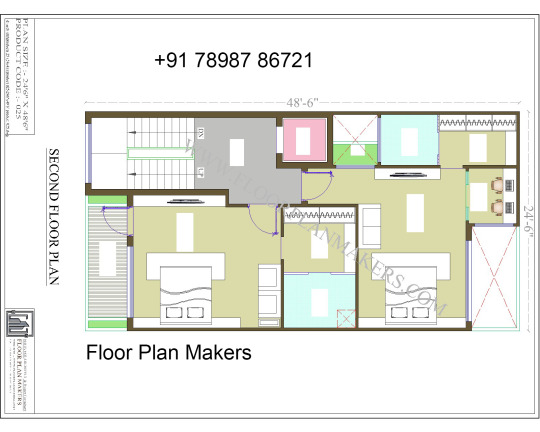
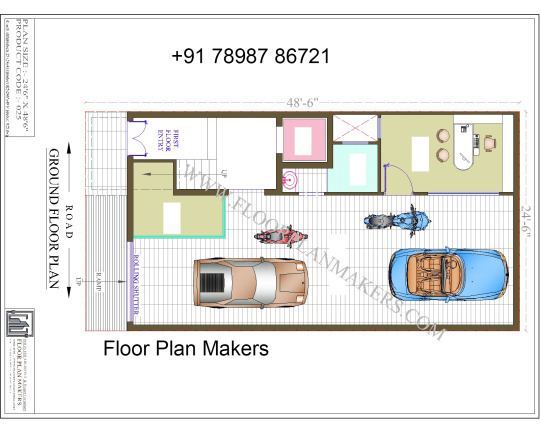
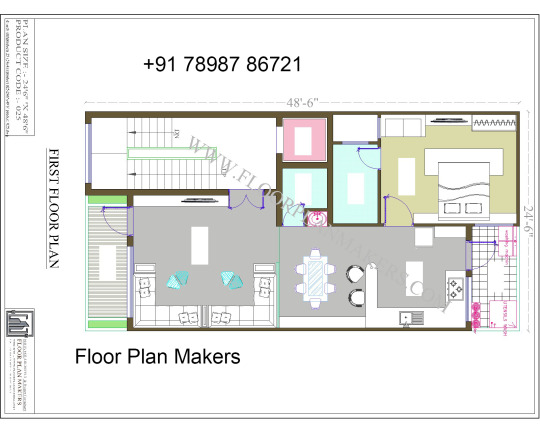
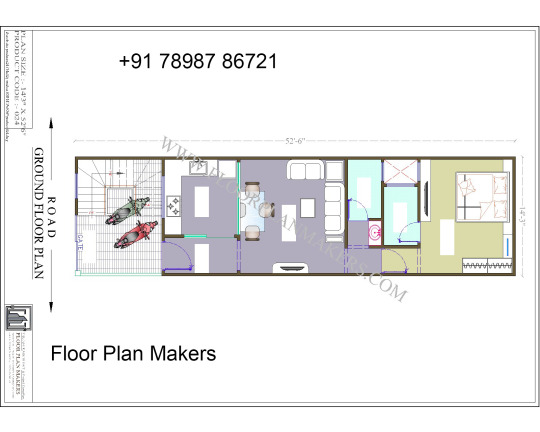
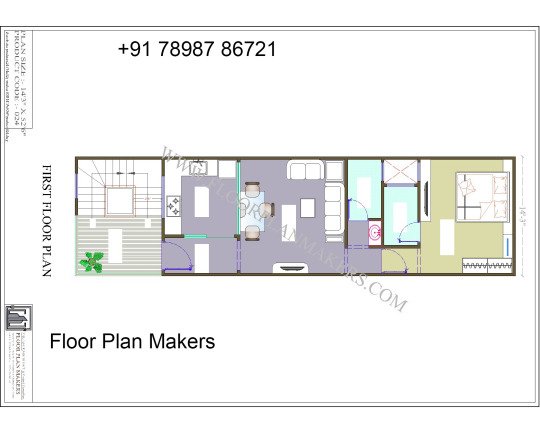

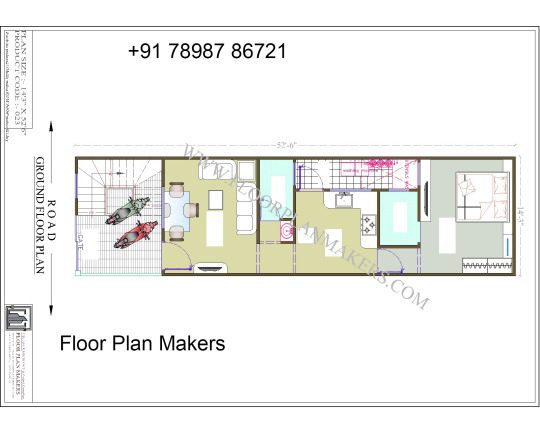
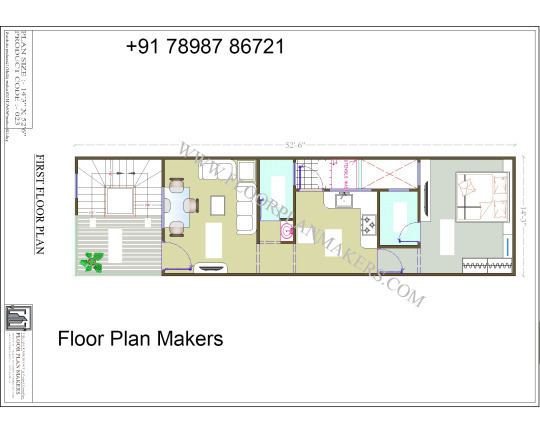
If you're looking for floor plan makers that are beginner-friendly, here are some great options: ### 1. **Floorplanner**- **Platform**: Web-based- **Features**: Offers a drag-and-drop interface, a library of furniture and fixtures, and the ability to create 2D and 3D floor plans.- **Pros**: Easy to use with no download required, basic version is free, and you can upgrade for more features.- **Best For**: Quick and simple floor plans. ### 2. **SketchUp**- **Platform**: Web-based and Desktop (Windows and Mac)- **Features**: Allows you to create detailed 3D models of floor plans with various textures and lighting effects.- **Pros**: Versatile and suitable for both beginners and more advanced users. Has a free version (SketchUp Free) and a more robust paid version (SketchUp Pro).- **Best For**: Beginners who may want to grow into more advanced design capabilities. ### 3. **Roomstyler 3D Home Planner**- **Platform**: Web-based- **Features**: Drag-and-drop design with a vast library of real-life products from popular brands.- **Pros**: Simple to use, especially for interior decoration, and has a large community for inspiration.- **Best For**: Beginners who are more interested in interior design. ### 4. **Sweet Home 3D**- **Platform**: Desktop (Windows, Mac, Linux)- **Features**: Offers a straightforward interface for designing floor plans and interior layouts in both 2D and 3D.- **Pros**: Free to download and use, with a decent range of features. Great for beginners.- **Best For**: Anyone looking for an offline tool with easy-to-use features. ### 5. **Homestyler**- **Platform**: Web-based- **Features**: Easy-to-use 2D and 3D floor plan creation with drag-and-drop functionality and a large selection of furniture and décor items.- **Pros**: Offers high-quality 3D visuals and is great for both planning and visualizing designs.- **Best For**: Beginners interested in interior design and home staging. ### 6. **Planner 5D**- **Platform**: Web-based, iOS, Android, and Desktop- **Features**: Allows you to create detailed 2D and 3D floor plans and also offers a virtual reality mode for viewing designs.- **Pros**: User-friendly, with lots of pre-designed templates and a large object library. Supports multiple platforms.- **Best For**: Beginners who want a cross-platform tool with a user-friendly interface. These tools are designed to be intuitive and easy to use, making them great for beginners who want to start creating floor plans without needing extensive training or experience.
#floorplanmakers #floorplanmaker #floorplan #floorplanner #floorplanners #floorplanmakerinindore
#floorplanmakersinindore
#floorplanmakers#floorplanmaker#floorplan#floorplanner#floorplanners#floorplanmakerinindore#floorplanmakersinindore
0 notes
Text
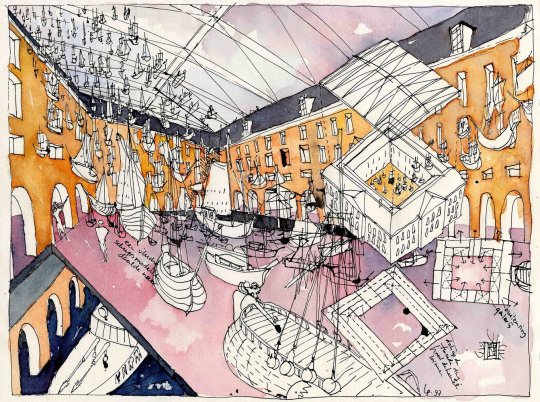
Hoarding: Ship models as documents and as aesthetic objects
Many museums have traditionally had collections of ship models. The original purpose of the models varied from playing a significant role in the determination of the design of a new ship, to simply being the product of a hobbyist. There are few professional ship model makers still working in the traditional way. Philip Reed and his predecessor Norman Ough typify the often obsessive and rarely well-remunerated activity.
An online comment observed in 2023 that "Unfortunately, in recent years, many regional museums in the UK have sold off their ship model collections." Those collections that continue to exist tend now to serve less as documents and more as aesthetic objects. The Museum aan de Stroom in Antwerp has a large display of ship models on the top floor of the museum, but it's difficult to get close to them.
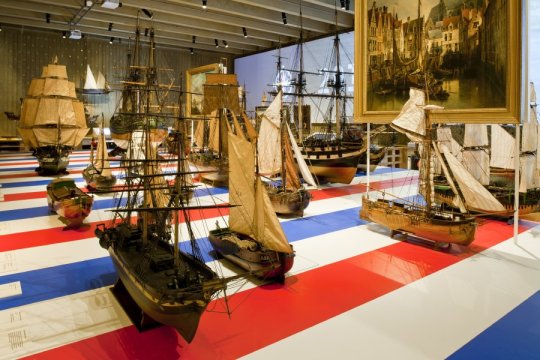
The visitor isn't expected to be able to extract information from the models, or use them for research, but merely to appreciate their picturesque beauty and craftsmanship. The Musée Mer Marine in Bordeaux has a hanging cloud of ship models.
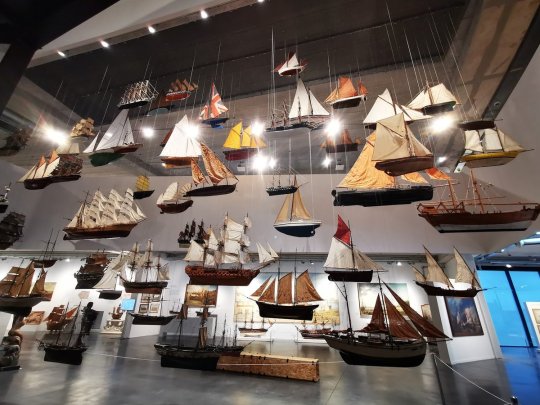
The Riverside Museum in Glasgow presents ship models on a moving conveyor, a kind of gimmicky way of saving space (thank Zaha Hadid for the concept). Liesbeth van der Pol made a architectural sketch in 2011, for the interior of the refurbished National Maritime Museum in Amsterdam, showing an armada of ships of all sizes descending into the courtyard. This plan wasn't realised, but it's indicative of the trend of using model ships as a material with which to make an impressive tableau, rather than as objects to be closely studied.
This trend might be OK, but what's worrying is that it may represent a step towards the total devaluation of ship models as items in a museum collection—it feels as presenting models en masse is the last stage before the museum decides to realise their monetary value as a commodity (rather than their "heritage" value as artefacts) by selling them individually to private collectors.
What seems important to me is that museums maintain the balance between viewing ship models as intriguing aesthetic objects and as factual historical documents. They might be a nuisance to conserve, and take up too much space—but if they must be sold, it seems essential to fully extract and record their documentary value before letting them go. The Science Museum made a 3D scan of their shipping gallery when it closed in 2012. This is nice to have, but I wonder what a truly thorough document of the collection would look like. As far as the ship models go, the Science Museum saw fit to commission (from some commercial photographers) a pictorialist photographic project on the subject of its ship models in 2017, involving images which aim for the misty, evocative and indistinct. As in the case of the Science Museum's other ventures into the image-making side of art and photography, the result is not encouraging.
0 notes
Text
Bungalow Makers is a premier architectural and interior design firm based in Indore, renowned for crafting exquisite living spaces that blend functionality with aesthetic appeal. Specializing in bespoke residential projects, Bungalow Makers brings a unique fusion of modern design principles and traditional elements to each project, ensuring a harmonious balance that reflects the client's personal style and needs. Their team of skilled architects and creative interior designers work collaboratively, offering end-to-end solutions from concept to completion. Whether it's designing luxurious villas, contemporary apartments, or stylish interiors, Bungalow Makers is committed to excellence and innovation. Their meticulous attention to detail and commitment to quality have made them a trusted name in Indore's design community, transforming spaces into elegant and comfortable homes. For those seeking to elevate their living experience, Bungalow Makers provides unparalleled expertise and a passion for creating beautiful, functional environments.
#architects & interior designers in indore#Best architect agency in India#Best Online Architect Services#best house designers#architectural and interior design company#Modern House Designs#Interior Designs Company#Duplex House Design#House Floor Plans#architects & interior designers in india#house plan#home plan#house map#naksha#house naksha#naksha maker#floor plan creator#floor plan designer#house design#floor planner#3d home design#3d house design
0 notes
Text
Showcasing Architectural Excellence Through 3D Animation
At 3D Rendering Pro, we redefine architectural visualization with stunning 3D architectural animations that breathe life into your designs. Whether you're an architect, real estate professional, or interior designer, our animations provide an effective way to communicate your ideas with clarity and precision. From sweeping aerial views to detailed interior walkthroughs, we craft animations that leave a lasting impression. Our 3D Architecture Animation services ensure that every scene captures the essence of the design, incorporating natural lighting, realistic textures, and seamless transitions. By turning blueprints into engaging visual narratives, we help you present your projects with confidence, making them more appealing to potential buyers, investors, and clients. Let us elevate your presentations with high-quality, cinematic 3D animations tailored to your vision.

#3d animator#3d animation services#3d model#3d movies#3d modeling#3d render#3d animation company#3d animation#3d animated film#3d rendering services#3d reality#3d art#3d artwork#3d visualization#3d movie maker#animation services#visualization#visualization techniques#rendering services#3d rendering company#2d art#2d animated film#2d animator#2d animation#2d animated video#2d render#2d floor plans
0 notes
Text
Best Architecture in Jaipur - Discover the pinnacle of architectural excellence in Jaipur with New House Designing. Renowned for blending traditional Rajasthani elements with modern aesthetics, our designs create stunning, functional living spaces. Each project reflects our commitment to quality, innovation, and sustainability, ensuring your home is both beautiful and eco-friendly. From intricate jharokhas to contemporary facades, our expert team crafts unique, personalized homes that celebrate Jaipur's rich heritage while embracing the future. Trust New House Designing to bring your vision to life with unmatched craftsmanship and attention to detail, making us the best choice for architecture in Jaipur.
0 notes
Text
Exploring House Plan Design Software: Unleashing Creativity and Precision
Exploring House Plan Design Software: Unleashing Creativity and Precision In the dynamic world of architecture and interior design, house plan design software plays a pivotal role. These powerful tools empower both professionals and enthusiasts to visualize, create, and refine their dream homes. Let’s delve into the fascinating realm of house design software and explore its impact.To get more news about house plan design software, you can visit gstarcad.net official website. The Evolution of Home Design Tools Virtual Architect Ultimate Home Design: This comprehensive software offers an array of features, including 2D and 3D views, material customization, and landscaping options. It’s a go-to choice for architects and homeowners alike. Total 3D Home, Landscape & Deck Premium Suite 12: Balancing affordability and functionality, this value-packed suite provides tools for designing interiors, exteriors, and outdoor spaces. Chief Architect Premier Professional Home Design: For those seeking professional-grade precision, Chief Architect delivers. Its robust capabilities allow intricate detailing and accurate measurements. User-Friendly Options SketchUp Pro: Collaborative and intuitive, SketchUp Pro lets users create 3D models, collaborate with others, and explore various design angles. Ideal for architects, designers, and hobbyists. RoomSketcher: Simplicity meets versatility. With an easy-to-use interface, RoomSketcher enables users to create floor plans, experiment with layouts, and visualize their ideas. Space Designer 3D: A browser-based tool that transcends platforms. It offers 2D and 3D views, allowing users to arrange, edit, and apply custom surfaces effortlessly. Canva’s Free Online House Plan Creator For a quick start, Canva provides a free custom home plan maker. With templates, unlimited whiteboard space, and user-friendly tools, you can sketch out your dream home online.
SmartDraw: Where Creativity Meets Practicality SmartDraw caters to both novices and professionals. Its templates, symbols, and floor plan tools facilitate interior design, remodeling, and architectural visualization. Fortune 500 companies trust it for its ease of use and versatility.
Conclusion Whether you’re an aspiring designer or a seasoned architect, house plan design software opens doors to creativity. From envisioning layouts to fine-tuning details, these tools transform ideas into tangible blueprints. So, grab your digital pencil and let your imagination flow!
0 notes
Text
i had an idea for a comic so i started drawing it thinking oh well ill just throw some lines around cuz all i want is to make this idea i have consumable in some way so the art isnt that important as long as it gets the point across. and now its a month later and im messing with 3d reference models digging through stock image galleries for more references and using 3d floor plan makers to work out angles . all while knowing full well that i cant draw humans . i already almost finished it once only to restart entirely because i didnt like it
1 note
·
View note
Text



~Happy Holidays!~ Finally, I am catching a break and I'm so happy to start chillin' with some DLC (downloadable content) in my room. I used DLC as a shitty gaming alternative to TLC (tender loving/love and care), but it's true! Before a few days before Christmas, I just could not remember the last time I played a videogame--the last time I even touched a joystick! I was going through a "withdrawal" period. I wasn't experiencing the actual symptoms of proper substance withdrawal, just this constant realization that every work day passing was another day in my life I was not gaming, another day without Sonic or Mario or Smash Bros., all my faves. But this also helped me realize that this is just where I am right now. Times have changed. My body and mind have changed, and I'm not the "Sonic-X-at-7AM-Saturday-Morning" kid I once was. And you bet I'd be playing Sonic games (SA2 mostly, if I recall) after watching the show that same morning until around noon. I'm thankful I was lucky to have that--HELL I'm thankful to be privileged to still have access to have that, I just have a bit less time now. AHEM but that was about a week ago, this is now! I wanna show you something!
You know "Supa Paypa Sistas", right? It was the best stop-motion animation video I've made in years. It was also the...only one of mine that have made it onto the internet... All the other ones I've made are either lost to/in time, or stowed away on my Windows 7 (the best one) laptop's hard drive. You can re/watch the film via the embed YouTube video, or the post link from the start of this paragraph.
youtube
Below are the work-in-progress posts I put on Tumblr leading up to the completed film.
https://theclo4ked1.tumblr.com/post/703490039983800320/the-black-box-a-wip-stop-motion-animation-shot
https://theclo4ked1.tumblr.com/post/703689454131478528/supa-paypa-sistas-no-longer-the-black-box
There exists a third draft video that's not on Tumblr and has only ever been used for an outside purpose. Y'know, it's been about a year since I finished that film. I suppose this post is something of an anniversary, and that makes me proud. Without further ado, NOW! for the moment you've been waiting for: what I wanted to show you! Since Tumblr allows only one video per post, I've compiled the forgotten tests and extras I did just before working on "Supa Paypa Sistas", all in a neat Windows Movie Maker package for you :3 They're rough and run slower than the final film because I had initially underestimated the 3DS' ten frames/second animation runtime and did animation on twos instead of ones. Beneath the video I'll detail some things about each cut.
Music: Is That You or Are You You? - Chris Zabriskie
The camera easing test was probably done just as a test. Easing was a concept I've applied already in 2D animation, but in stop-motion, I needed this to create something of higher quality.
True, before the box, there was this bear thing that transformed in a kraken because a super pill went up its butt. I dunno what I was thinking last year, it was late at night.
All three of Veretta's animation tests were just ways of getting the film to start. Two of the cuts were based around the idea of her creation. You can see she was originally put together with just tape before I turned her and Nina into paper dolls using string to increase efficiency. There's one frame at the end of the third test where you can see the circle where Veretta's shoulder connects her arm to her body.
The bouncing box was another easing test to simulate physics with the box's reaction gravity and material. I never thought of what that material is.
Nina's only appearance before the film started was her sliding on the ground.
Veretta's final cut, also the final of the cutting room floor, is her just falling. This was probably a test put after a planned creation since that's what happens with Nina after her creation in the film.
The last thing I want to share are these two photos I captured of the two sisters on December 7, 2022, after I had drawn and cut out all of their limbs. Since the faces were drawn with pencil, I was able to erase and create new expressions when I needed, but Veretta's left facing face was harder to change because I pressed the pencil to hard, so she kinda had a "resting Donkey Kong face".
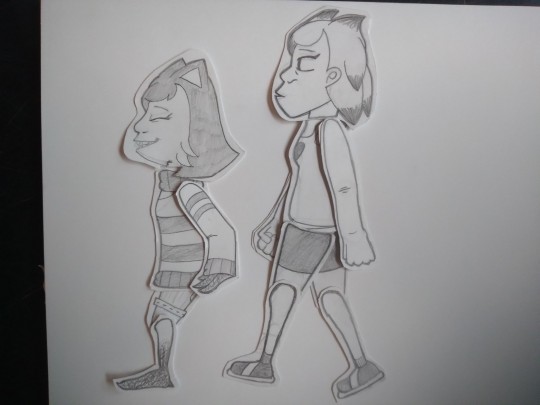
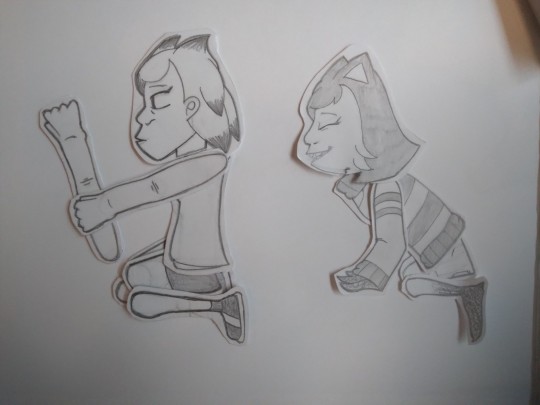
In an email explaining my animation process, I told my recipient "Nina and Veretta are bristol board paper dolls I made using 8 limbs each: Head, torso, 2 pairs of full length arms, 2 pairs of thighs, and 2 pairs shins/foot parts, ALL painstakingly cut, and bonded by tape, glue and string to create two girls." I think that's all I wanted to say about my little film. I hope to make more things like that in the future, but maybe not with those puppets, they're relics now. I keep them in a drawer of other stuff I've made "by hand" in the last, maybe, eight years? They even have the same expressions I left them with after the film ended. Up for auction: never. Thanks for reading!
0 notes
Text
Week 2 - Local Module
Monday 25th September -
In today's session we started by discussing this weeks reading, which were texts from 'Design for inclusivity' and 'Frame Domus academy'. I'd highlighted my thoughts from each. The first being the use of the term 'change makers' as a substitute for designers. It emphasised how conscious-designers, are key in making a positive change in the future. Another reoccurring thought I had was the notion of designing environmentally consciously. This idea is obviously, recently an incredibly key aspect of design, however, I didn't realise it had been such a key part of design before. I assumed that sustainable practices were more modern, however, it has been a conscious effort for a while in the same sense that human damage to the earth has been an issue for a while. It was also stated that 'design education is a catalyst for change'. The art of working environmentally consciously is key in creating positive change, and that all starts in the teaching of design. To engrave an ethical habit in designers as they're learning will further impact their work and ensure there is a conscious effort to work sustainably. I feel that even now, in the early stages of my design career, I often am considering ways in which the ideas I explore are environmentally friendly. I think this is potentially why it stood out to me in the text as I somewhat personally resonated with this idea.
From 12:00 we completed our first vector works workshop. We went over the basic tools, creating shapes, joining them together to make more complex shapes and rendering them to 3D. We also imported the Foyle studio floor plans into the programme so that we could eventually create an visual display of what the setting of our activities will look like.
For the afternoon of the session I continued to brainstorm and configure ideas for the project. I had been considering a few and had two ideas that | became somewhat torn between. The first being to create pieces of art that display a short quote from the individuals, giving their best advice for younger generations. This idea came to me after seeing a video on Instagram. I have followed the page for a while and after seeing a video I thought of the relevance to the culture club and the idea that speaking to members of an older generation is potentially more appropriate as they have life experience and potential wisdom to share. My other idea was to create a tik tok page. I considered the biggest difference in generations and I thought about social media, and the biggest social media platform at the minute that seems to be tik tok. I thought we could choreography a dance that can be done either sat down or stood up, catering to all, and then film and post the video on a 'culture club' tik tok page. The idea of getting those in the group excited about social media was interesting to me as it acted as a way of involving them in modern trends that the may otherwise not understand, or feel a part of. I added each ideas to a miro mind map so that I could see each of the ideas side by side and weigh up each of the positives.
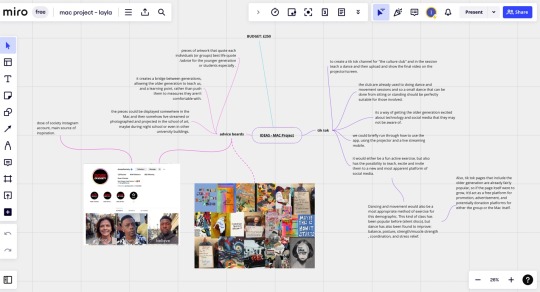
Wednesday 27th September
in Wednesdays session it was more developing and researching for our ideas. Because I was torn between the two I was trying to weigh out the positives and negatives of each of the ideas. I considered the involvement of music in the tik tok idea and how low impact movement to music would be beneficial for health, as well as the positive impact on the mind. I also considered that the inspiration board idea potentially prompts more thought and conscious decision, but again isn't too taxing and so this too is quite an appropriate idea. I really struggled choosing between the two and so thought I'd further develop them each to see which overall seemed the stronger idea.
Later on I had my first tutorial with Lara. It was very useful. She seemed interested and supportive of Both ideas and what could be done with each of them and so agreed that it was best to further develop the ideas and come to a final conclusion as to which may work best. We also discussed the potential of combining the two somehow and using ideas from each so that I wasn't completely eliminating a whole idea that had some good features. I think again this idea would only work if I developed on the ideas that I had, and then reflect to see which of the ideas within each could potentially be merged together.
0 notes